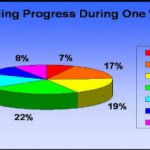Davis Research Studies
 The Davis Dyslexia Correction program was developed by Ronald Dell Davis from independent experimentation and research, beginning in the early 1980’s. Davis, who was himself severely dyslexic, had discovered a simple mental technique that radically improved his ability to focus on print. Through clinical experience working with dyslexic adults and children, Davis and his colleagues improved and refined the methods over time.
The Davis Dyslexia Correction program was developed by Ronald Dell Davis from independent experimentation and research, beginning in the early 1980’s. Davis, who was himself severely dyslexic, had discovered a simple mental technique that radically improved his ability to focus on print. Through clinical experience working with dyslexic adults and children, Davis and his colleagues improved and refined the methods over time.
In 1994, after working with more than 1,000 clients, Davis published the first edition of The Gift of Dyslexia, detailing his methods and the theory behind them. Since that time, hundreds of professionals have received advanced training in Davis methods, and licensed Davis Facilitators have collectively worked with more than 20,000 clients.
In the years since, many scholars have studied the implementation and effectiveness of Davis techniques. Below is a summary of various studies which have been published in peer-reviewed research journals, presented as conference papers, or submitted as academic dissertations.
- Contextualizing Davis Dyslexia Correction Program to Filipino Youth Dyslexics
- (2022 - Journal Article and Open Access)
Case Study describing informal implementation of Davis methods as described in The Gift of Dyslexia by researchers working with three individuals.
- Comparison of the effect of Davis instructional strategy and traditional instructional on the development of reading skills of dyslexic boys in grade 2 of elementary school from Roshtkhar
- (2021 - Journal Article)
Comparative group study of 10 dyslexic boys in grade 2, randomly assigned to either a Davis intervention or traditional intervention group. The Davis group showed significantly greater improvement at post-test.
- The Effectiveness of Davis Training on Improving Student Reading, Planning and Organizing Skills
- (2019 - Journal Article and Open Access)
Randomized study of 15 children given Davis program as compared with a control group of 15 children recruited from learning disabilities centers.
- Clay’s the Thing: Clay Work for Mastering Spelling
- (2018 - Journal Article and Open Access)
Case study of four students exploring impact of Davis program and Davis Symbol Mastery on learning engagement and spelling ability.
- Comparison of the Efficiency of Neuropsychological and Davis Method Interventions on Reading Performance of Dyslexic of First and Second Grade Elementary Students
- (2018 - Journal Article)
Comparative group study of 45 dyslexic first and second-grade students. Students were assigned to experimental groups receiving either Davis Dyslexia based intervention or a neuropsychological intervention, or to a control group receiving no specialized intervention.
- Davis Learning Strategies in New Zealand Schools Action Research Inquiry 2018
- (2018 - Agency Report)
Survey of reported results and progress reports from 10 New Zealand schools after implementation of Davis Learning Strategies school program.
- The Effectiveness Of Orientation And Symbol Mastery On The Quality Of Reading In Dyslexic Boy Students
- (2017 - Journal Article)
Controlled Study with pre-test / post-test design of 30 dyslexic third-grade boys.
- Not Just Playing With Clay: Symbol Mastery for Spelling and Word Comprehension
- (2016 - Journal Article)
Small group study exploring impact of Davis methods on spelling ability of children ages 11-16.
- Efficacy of Davis Dyslexia Correction Program on Rereading Performance of male students with Dyslexia
- (2015 - Journal Article and Open Access)
Controlled, quasi-experimental study of 30 third-grade males given 16 30-minute sessions of Davis-based individual therapy.
- Dyslexia and children's English language learning in a Mexican elementary school: A crowdsourced intervention study
- (2015 - Academic and Academic Dissertation)
Qualitative Research exploring impact of multiple strategies for dyslexic English language learners in a classroom context, including clay modeling of letters and words based on Davis Symbol Mastery.
- Symbol Mastery and the Retention of Dolch Spelling Words
- (2014 - Academic and Conference Paper)
Small group study exploring use of Davis Symbol Mastery for learning spelling of homonyms on the Dolch word list.
- The Effects Of The Davis Symbol Mastery System To Assist A Fourth Grader With Dyslexia In Spelling: A Case Report
- (2012 - Academic and Journal Article)
Case study, using Davis Symbol Mastery to assist a fourth grade boy with a diagnosed learning diability to learn spelling words
- Effectiveness of Davis Dyslexia Correction Method on Reading Performance of Dyslexic Children
- (2012 - Academic and Journal Article)
Randomized controlled study comparing 20 dyslexic third grade boys receiving Davis-based tutoring with a control group.
- Effect of the Davis training method on self-concept children with dyslexia
- (2012 - Academic and Journal Article)
Randomized controlled study; psychological benefits of Davis program. Third grade boys receiving Davis-based intervention showed significant improvement in educational, athletic, and social self-conceptualization.
- The Comparison of the Effectiveness of Fernald and Davis Method on Reading Performance in the Dyslexic Students
- (2012 - Journal Article and Open Access)
Experimental study of Davis-based intervention, Fernald-based intervention, and two matched control groups comprised of dyslexic third graders. Results showed significant post-test differences among intervention groups.
- La dyslexie et les difficultés qu’elle peut poser à l’établissement de la relation pédagogique
- (2012 - Academic Dissertation)
French language Master’s thesis by a licensed Davis Facilitator, including a detailed single case study of a young adult completing a Davis Dyslexia Correction program.
- Effects of the Clay Modeling Program on the Reading Behavior of Children with Dyslexia: A Malaysian Case Study
- (2011 - Academic and Journal Article)
Case study of use of Davis Symbol Mastery and Davis Reading Exercises with three students
- Impact of Davis Dyslexia Correction Method on the Improvement of the Adult Dyslexic's Reading Skills
- (2011 - Academic and Journal Article)
Researchers investigated the efficiency of Davis Dyslexia Correction Method on reading skills of 16 randomly selected adults, age 17-40.
- The Davis Model of Dyslexia Intervention: Lessons from One Child
- (2010 - Academic and Journal Article)
Case Study reporting progress of a 9-year-old student using Davis Dyslexia Correction techniques.
- Effect of Ron Davis approach and Eclectic approach on reading ability among primary school dyslexic children
- (2010 - Academic Dissertation)
Comparative Group Study, comparing pre/post treatment outcomes of 30 third and fourth grade students (age 8-11) taught with either the Davis approach or an eclectic approach designed by the researcher, with a control group receiving traditional classroom instruction.
- A Case Study Evaluating the Ronald Davis' Orientation Counselling and Symbol Mastery Procedures for Correcting Dyslexia
- (2009 - Academic Dissertation)
Case Study
- A Case Study in Teaching Reading to the Adult Learner
- (2009 - Academic and Academic Dissertation)
Case study, using a combination of a traditional tutoring approach (Wilson Reading) and Davis Alignment with adult student.
- Enhancing intermediate dyslexic learners' literacy skills: a Free State community project
- (2009 - Academic and Journal Article)
Controlled Study, comparing outcomes of 18 intermediate school dyslexic learners who received Davis-base tutoring over a period of 9 months, with a matched control group receiving traditional tutoring.
- The effect of the Ron Davis programme on the reading ability and psychological functioning of children
- (2005 - Academic and Academic Dissertation)
Study of academic and psychological progress of 10 dyslexic students compared with a matched control group of 10 students.
- The Effectiveness of Davis Dyslexia Correction Method Re-examined in Iran
- (2005 - Academic and Journal Article)
Researchers taught two randomly selected students using Davis Orientation Counseling and Symbol Mastery, and compared progress with two matched controls
- Three-dimensional clay modeling instruction: A pathway to spatial concept formation in second language learners.
- (2003 - Academic and Academic Dissertation)
Study of Davis -based clay modeling as a study technique for university students learning a foreign language.
- Confronto di efficacia ed efficienza tra trattamenti per il miglioramento della lettura in soggetti dislessic
- (2003 - Academic and Journal Article)
Study comparing rate and level of reading skill improvement of students taught with one of eight different methods of dyslexia intervention; the group receiving Davis Orientation counseling showed the greatest improvement in reading speed, and the most rapid rate of improvement.
- The Effect of the Davis Learning Strategies on First Grade Word Recognition and Subsequent Special Education Referrals
- (2001 - Academic and Journal Article)
Longitudinal study of 86 primary level students taught with Davis strategies in 3 groups. Students scored significantly higher on recognition of basic sight words than students in matched control groups.


